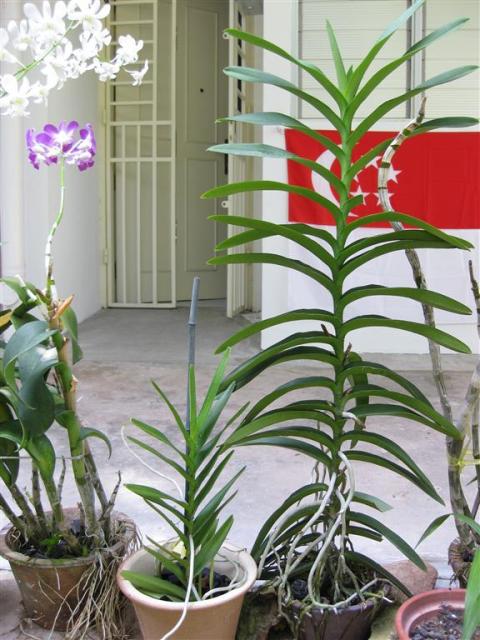QuestionQUESTION: Hi Wayne King,
I've asked about my vanda flower spikes that stay at the same point.You suggested me to do dunking every morning. I exactly follow, but it never get bigger & elongate. It still stay at the same starting point. It has been two & a half month already.
Anything still wrong with my plant? My vanda is getting 5-6 hrs light everyday. I water every morning or alternative morning.But, now it has a lot of new roots coming out.
I'm using blooming fertilizer once a week. Shall I switch to 20-20-20 now or how?
Any idea to get my spike bigger?
Thanks in advance,
New Lay
ANSWER: My intial thought on this is that 5-6 hours of light per day is the problem. This should be 15-16 hours of light per day. Try to time the light exposure to your natural day length. Vandas, ascocendas,and other vandaceous alliance plants need a great deal of light-- just short of burning-- to achieve their miaximum potential for growth and flowering. I prefer to see a slight reddening of the leaves to ensure that they receive good light. Burning is less of a problem as the sun's angle decreases durng the fall and winter months.
---------- FOLLOW-UP ----------
QUESTION: Hi Wayne King,
Thanks for your reply.
The problem is that there is no spot which receiving 15-16 hrs of light.
My house front side is getting sun light from 10am to 5pm. I keep my vanda there. Its leave are very light green. My mokra leave are yellow -green.
My house back side is receiving only afternoon sun from 4;30 pm to 6:00 pm.
If light is the case here, I have no choice.
Would there be a solution for this light issue?
Thanks in advance,
Nwe Lay
ANSWER: The appearance of new roots is encouraging. I take it you do not have a tree away from the house that may provide more light exposure were you can hang it. You didn't mention how much of the light exposure is direct sun light. A yellow-green color to the leaves is encouraging. I can't recall if your vanda is fairly mature (eg at least 18 inches tall). Immature plants (eg first time bloomers) may try to push several spikes but don't yet have the energy to bring the flowering to fruition. If you can't provide more light, then, patience may be your best friend.
---------- FOLLOW-UP ----------
 My Vanda
My Vanda
QUESTION: Hi Wayne King,
Thanks again for your reply.
The light exposure is very very strong. It even has some
slight sun burn.
My vanda is quite mature plant at two and a half feet tall.
Yeah, I don't have a tree away from the house that can
provide more light exposure. It is in unglazed clay pot as I
don't have a place to hang it. But, one thing I can tell you
is a lot of new roots including very big one are coming out
& some even attached to the floor. I always make sure all
roots are dry out after each watering.
AnswerThanks for the picture. My observations from the picture you sent (recognizing that photos often don't accurately reflect their subjects): the leaves appear to be too deep a green color to reflect substantial exposure to bright light (eg. in the photo I do not see the sun burn to which you referred); there is evidence of old flower spikes showing that the plant has flowered but several years ago; there are new roots but these come from near the base of the plant; I can see no evidence of new flower spike appearance. As you indicated, this is a mature plant. On a well grown plant of this type, I would expect to see new roots and plant side branches in the upper half of the plant where none appear. Flowering should also occur near the top8 inches or so. I don't recall if this plant is a named cross, but, if so, it might be helpful to know it. The spikes to which you refer may, in fact, be new roots as, in the eary stages, new roots and new flower spikes have a similar appearance.
From what you have told me, it sounds as if you can do about all you can do. With patience, it may yet reward you with a flower spike. Remember, it appears as thought his plant has gone several years without flowering. Your care sounds appropriate and the plant is responding. I urge continuing to provide it with the best care you can and, as long as the plant is putting on new growth, you may yet have a flower spike-- if not this year then next.






